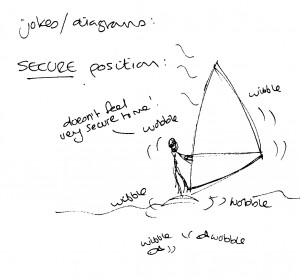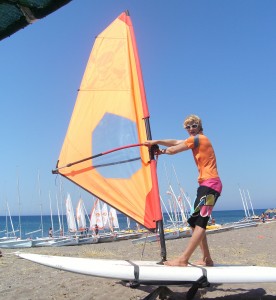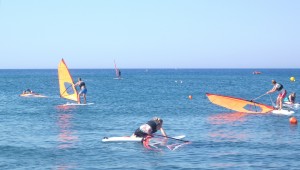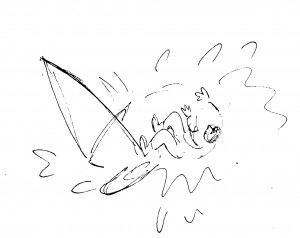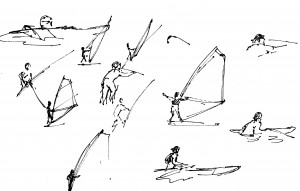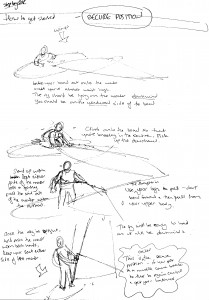Wobbling on water
Everything wobbles when you stand on a windsurfer for the first time. The board wobbles, the sail wobbles, the water wobbles and so I wobbled. Balancing on a plastic plank is a novel sensation to someone more used to being on the water in hefty wooden boats. By the third lesson I was getting the hang of it, helped by small sails, light winds and a team of tanned, blond and unfailingly cheerful young instructors. It’s all about balance and getting the body position right; on a windsurfer you are part of the machine.
I was doing all this watery wobbling on the island of Lesvos in Greece, courtesy of Nielson’s holidays. My mission – to learn enough about windsurfing and the methods of teaching it to spend the next nine months or so writing and illustrating the beginner’s guide for youngsters.
Not being a sporty type, I was a bit worried about whether I’d be able to keep up. The resort offers a packed programme of activities every day including mountain biking, jogging, waterskiing, wakeboarding, yoga, keep fit, swimming, kayaking, sailing, windsurfing and volleyball. If that makes you exhausted just thinking about it, there’s always the unofficial programme which includes sitting by the pool, watching Wimbledon in the hotel foyer, twiddling with laptops and iphones in the wifi zone, choosing cocktails, eating vast quantities of delicious food every mealtime and sitting on the veranda with a book and a glass of wine. I had to stay fairly focussed, with windsurfing in the morning, working on notes and sketches in the afternoon, rounding off the day with a swim in the sea or pottering around in dinghy or kayak.
Instructor Rupert showing us all how to gybe; nifty footwork and flicking the sail around the front of the board is the key. Doing it on moving water? Now, that’s another story!
Oops. One down, all down. No, of course there aren’t any photos of me making a fool of myself – for this shot I was safely in a kayak, camera at the ready, trying and failing to photograph people at the exact moment of falling in. There are times when research is very enjoyable!
I’ll just have to imagine what someone looks like at the moment of falling in. Something like this I guess.
Now the fun part is over and the hard work begins. I have to work the alchemy that every writer and illustrator is familiar with – challenging the empty page with rough scribbles, both verbal and visual, then working them up into a polished series of pages that not only informs but delights the reader.
Here’s the raw material. Very raw. Well, I’ve never drawn windsurfers before and they kept moving around.
After each lesson, I spent time analysing what we’d been taught and breaking it down into simple stages. You see, all good drawings start as bad ones! And I’m not afraid to admit to starting with stick figures when I need to.
How-to books can be very dry and dull. The joy of writing for children is that I have licence to add jokes, and explain everything in a fun, colloquial way. And if adults find it useful too, it just goes to show that we’re all children at heart!

